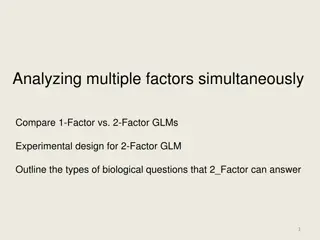
Generalized Linear Models: Understanding Regression Challenges and Transitions
Explore the challenges of linear regression in predicting binary and count outputs, transition to logistic regression for probability predictions, and delve into the Generalized Linear Model (GLM) approach for optimizing parameter characteristics in regression analysis.
Download Presentation

Please find below an Image/Link to download the presentation.
The content on the website is provided AS IS for your information and personal use only. It may not be sold, licensed, or shared on other websites without obtaining consent from the author. If you encounter any issues during the download, it is possible that the publisher has removed the file from their server.
You are allowed to download the files provided on this website for personal or commercial use, subject to the condition that they are used lawfully. All files are the property of their respective owners.
The content on the website is provided AS IS for your information and personal use only. It may not be sold, licensed, or shared on other websites without obtaining consent from the author.
E N D
Presentation Transcript
B4M36SAN Generalized Linear Models Anh Vu Le & Jan Blaha
What Linear regression struggles with Predicting binary output and count output Giving reasonable predictions when: residuals are non-normal variance of residuals is changing
From Linear to Logistic regression What we have Linear model Simple to fit Predicts on the scale from 0 to What we want To predict probabilities Scale 0 to 1 ? = ?0+ ?1?1+ ?2?2+ Adapter function Derivation: ? Adapter function: Sigmoid ? = 1 ?= odds ? 1 ? = log = logit ? = 1 ? 1 + ? ? 1 ? = Now express p to get the sigmoid 1 + ? (?0+?1?1+?2?2+ )
Linear regression (GLM approach) 1. Determine the distribution of Y for each X 2. Goal: predict a parameter characteristic for the distribution 3. Express, how well the predictions fit the data 4. Maximize this quantity w.r.t. to the regression coefficients (MLE) Normal distribution 2??exp (? ?)2 1 ?(?) = 2?2
1. Determine the distribution of Y for each X 2. Goal: predict a parameter characteristic for the distribution 3. Express, how well the predictions fit the data 4. Maximize this quantity w.r.t. to the regression coefficients (MLE) Regression for binary data Bernoulli Pr(X = y) = ??(1 ?)1 ? p ... Chance of success y ... {0,1} if the success happened or not
1. Determine the distribution of Y for each X 2. Goal: predict a parameter characteristic for th distribution Convert regression output to the scale of through the adapter function 3. Express, how well the predictions fit the data 4. Maximize this quantity w.r.t. to the regression coefficients (MLE) Regression for binary data Bernoulli Pr(X = y) = ??(1 ?)1 ? p ... Chance of success y ... {0,1} if the success happened or not ? = ?0+ ?1?1+ ?2?2+ ???????(?) ?????(?)? ? ?
1. Determine the distribution of Y for each X 2. Goal: predict a parameter characteristic for the distribution Convert regression output to the scale of through the adapter function 3. Express, how well the predictions fit the data 4. Maximize this quantity w.r.t. to the regression coefficients (MLE) Regression for count data Poisson Pr ? = ? =??? ? ?! ? ... Average rate of events k ... Observed count of events ? ? = ? ??? ? = ? ? = ?0+ ?1?1+ ?2?2+ exp(?)? log(?)? ?
macbookpro_1477920514956.jpeg (800 533) (gadgets360cdn.com) https://preview.redd.it/61qzo3egumo11.jpg?width=960&crop=smart&auto=webp&s=445019148a08059959f25ed33e6d5fa6c8e522ed 19" CRT monitor SAMSUNG SyncMaster 997MB LH19ISBBS/EDC slono | kak.cz 87b9db78647912d4bf3bca0309e86648.png (480 359) (pinimg.com) https://bookdown.org/roback/bookdown-BeyondMLR/ch-poissonreg.html Generalized Linear Models Decomposed | by Daniel Friedman | Towards Data Science Poisson distribution - Wikipedia




